10 Garden Ideas for Winter Interest
You don’t have to let your garden become a dreary space during the cold months. By incorporating key design elements like structural evergreens, vibrant winter stems, and strategic lighting, you’ll create a landscape that sparkles with life even on the darkest days. From the graceful swaying of ornamental grasses to the bright berries that attract winter birds, there’s a wealth of options to transform your outdoor space into a captivating winter wonderland. Let’s explore ten proven ways to add year-round appeal to your garden.
Contents
- 1 Evergreen Structure and Form
- 2 Ornamental Grasses in Winter
- 3 Colorful Winter Stems and Bark
- 4 Berries and Winter Fruits
- 5 Winter-Flowering Plants
- 6 Sculptural Elements and Garden Art
- 7 Textured Foliage and Leaves
- 8 Strategic Lighting for Dark Days
- 9 Winter Container Displays
- 10 Native Plants for Winter Wildlife
Evergreen Structure and Form
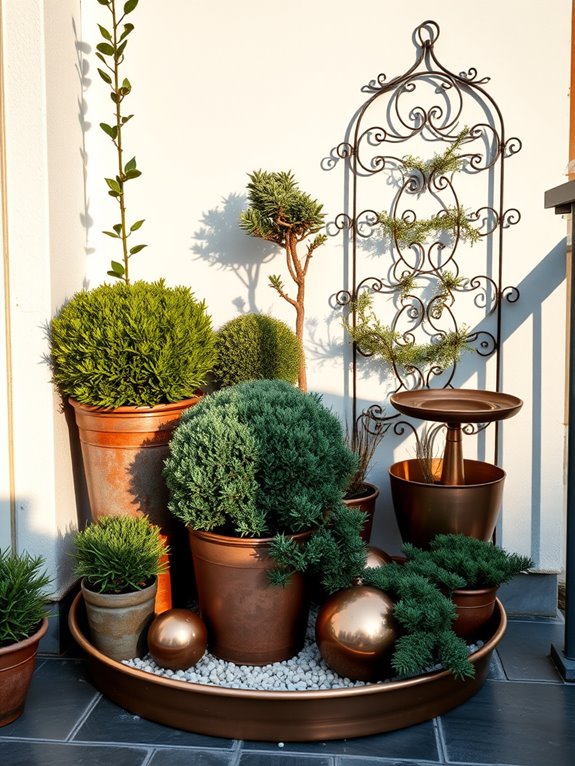
The stark beauty of winter reveals itself through a carefully planned evergreen garden, where sculptural forms stand as bold sentinels against frost and snow. Stately columnar junipers rise like green arrows pointing skyward, while rounded boxwoods create spherical anchors that ground the space in geometric harmony.
The layered branches of pine and spruce trees cast intricate shadows across pristine snow, creating a natural artistic display that changes throughout the day. This living architecture transforms what could be a barren winter landscape into a sophisticated outdoor gallery. Varying shades of green – from the silvery blue of Colorado spruce to the deep emerald of yew – provide rich visual texture.
Strategic placement of ornamental features like copper garden orbs, stone benches, and weathered trellises adds architectural interest while complementing the natural forms of evergreen plantings.
Key Elements:
- Upright evergreens (juniper, cypress)
- Rounded shrubs (boxwood, holly)
- Spreading evergreens (pine, spruce)
- Ornamental structures (obelisks, trellises)
- Garden art (spheres, sculptures)
- Natural stone elements
- Gravel or stone pathways
- Winter-hardy container plants
- Outdoor lighting
Creating an evergreen structure garden begins with establishing the backbone of larger specimens as focal points. Place tall columnar varieties along boundaries or as dramatic accents, then layer in medium-sized rounded forms to create middle-ground interest.
Fill spaces between larger specimens with low-growing spreaders to prevent bare spots and maintain year-round coverage. Incorporate hardscape elements like gravel paths and stone walls to define spaces and provide contrast to the plantings.
Regular maintenance is crucial for maintaining crisp forms. Prune evergreens in late winter or early spring before new growth emerges, and again lightly in mid-summer if needed. Shape formal hedges and topiaries more frequently to maintain precise geometry.
Water deeply but infrequently during dry spells, even in winter, to prevent dessication. For smaller spaces such as balconies or courtyard gardens, consider dwarf varieties of evergreens in containers.
Use varying heights and forms to create the same structural impact in miniature. Combine container plantings with wall-mounted trellises or espaliers to maximize vertical space, and incorporate mirrors to create the illusion of depth.
Choose lightweight containers with excellent drainage, and ensure they’re rated for winter temperatures in your area. Group containers together during extreme cold for better insulation of root systems.
Ornamental Grasses in Winter
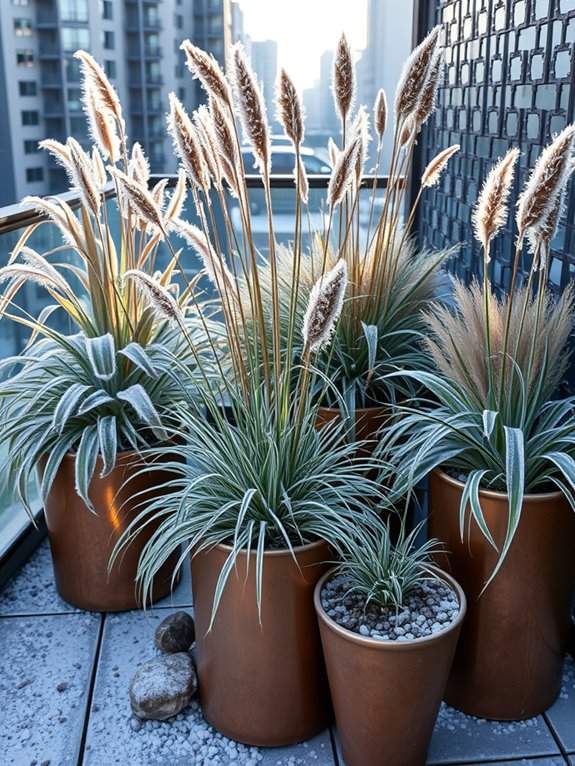
Ornamental grasses take on a magical quality in winter, transforming from their vibrant summer greens into stunning arrays of gold, bronze, and silver. As frost crystallizes on their delicate plumes and seed heads, these architectural plants create an ethereal display that catches both sunlight and moonlight.
Varieties like Miscanthus sinensis ‘Morning Light’ and Calamagrostis x acutiflora ‘Karl Foerster’ stand tall through winter storms, their graceful forms swaying in winter winds while providing structure and movement to an otherwise dormant landscape. The winter garden comes alive with the rustle and whisper of dried grass stalks, creating both visual and auditory interest during the cold months.
When planted in thoughtful groupings, ornamental grasses create natural screens and windbreaks, while their neutral winter colors provide the perfect backdrop for colorful winter berries or evergreen shrubs. The interplay of light and shadow through the grass stems adds depth and intrigue, especially when backlit by low winter sun.
Key Elements:
- Tall ornamental grasses (Miscanthus, Pennisetum, Calamagrostis)
- Medium-height grasses (Festuca, Deschampsia)
- Low-growing grasses (Carex, Ophiopogon)
- Decorative stones or gravel
- Winter-interest companion plants
- Path lighting or uplighting
- Weathered wooden elements
- Protected seating area
Implementation begins with selecting grasses that maintain their structure through winter, placing the tallest varieties at the back of borders or as focal points. Plant grasses in odd-numbered groupings, allowing adequate spacing for mature growth.
Create layers by incorporating different heights and textures, ensuring that all plantings are visible from primary viewing areas. Install lighting at the base of signature specimens to highlight their forms after dark, and incorporate pathways that allow close-up appreciation of frost-covered plumes.
Success with winter ornamental grasses depends on proper timing of maintenance tasks. Leave grass cutting until late winter or early spring, just before new growth begins, as the dried stalks provide winter interest and protection for the crown of the plant.
In regions with heavy snow, consider installing supports for taller varieties, and position plants where snow load won’t permanently damage their form. For smaller spaces like balconies or patios, focus on compact varieties such as Festuca glauca or dwarf Miscanthus cultivars in containers.
Use lightweight pots that can be easily moved and grouped for impact, and consider incorporating mirrors or reflective surfaces to multiply the visual effect of your grasses. Ensure containers have adequate drainage and elevation to prevent freezing damage, and select varieties that match the scale of your space while providing the desired winter impact.
Colorful Winter Stems and Bark
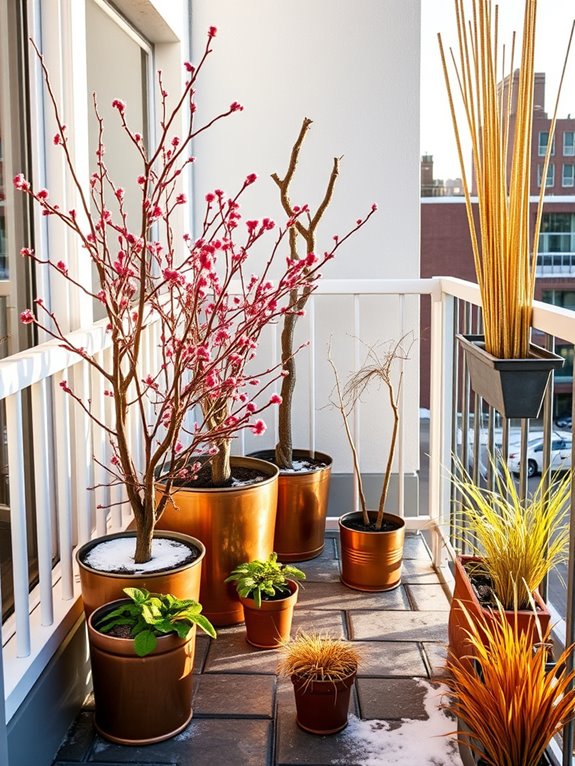
Transform your winter garden into a captivating display of color and texture with striking stems and bark that shine during the coldest months. Fiery red dogwood branches rise from frost-covered ground while the peeling bark of paper birch trees creates dramatic white sculptures against the winter sky. The rich mahogany stems of ninebark shrubs and the golden twigs of willow varieties add layers of warmth to the landscape, proving that gardens can be visually stunning even without flowers.
This architectural approach to winter gardening plays with light and shadow, creating an almost magical atmosphere as morning frost highlights every curve and crevice of exposed bark. The copper-colored stems of Tibetan cherry trees stand sentinel among patches of ornamental grasses, while the mottled patterns of crepe myrtle bark add intricate detail to the winter scene. When backlit by low winter sun, the garden becomes a gallery of natural art, with each plant contributing its unique textural signature.
Key Elements:
- Red-twig dogwood (Cornus sericea)
- Paper birch (Betula papyrifera)
- River birch (Betula nigra)
- Golden willow (Salix alba ‘Vitellina’)
- Ninebark (Physocarpus opulifolius)
- Tibetan cherry (Prunus serrula)
- Crepe myrtle (Lagerstroemia)
- Ornamental grasses
- Strategic lighting fixtures
- Mulch for contrast
- Winter-hardy ground covers
Plan your garden by creating layers, placing the tallest specimens like birch trees toward the back or center of the space. Group three to five shrubs of the same variety together for maximum impact, ensuring they’ve room to reach mature size.
Position plants with complementary bark colors near each other to create striking visual combinations. Maintain the display by pruning dogwoods and willows hard in early spring to encourage vibrant new growth for the following winter.
When designing this type of garden space, consider viewing angles from inside your home and position key specimens where they’ll be visible through windows. For smaller spaces or balconies, use container plantings of dwarf varieties like Arctic Fire dogwood or create vertical interest with climbing hydrangea vines that showcase exfoliating bark.
Incorporate mirrors to multiply the visual impact of colorful stems and consider using spotlights to illuminate particularly striking specimens during the shorter winter days.
Berries and Winter Fruits
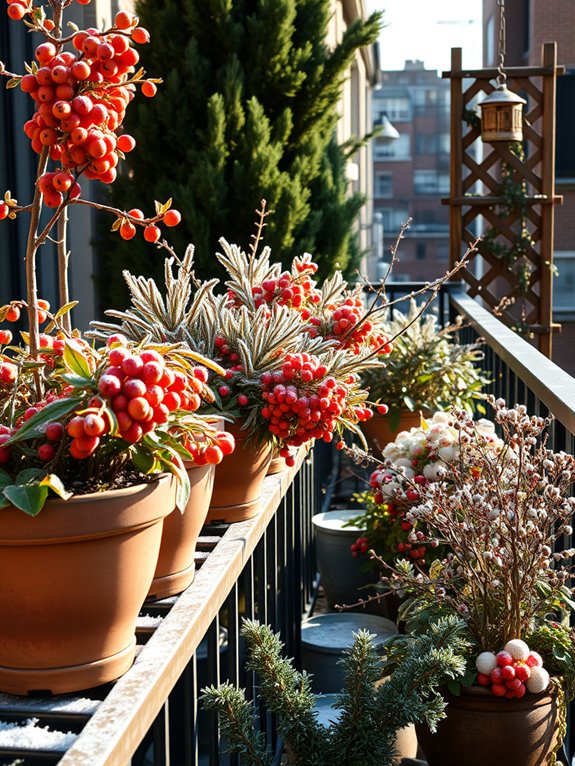
A winter garden adorned with berries and fruits transforms the stark landscape into a vibrant tapestry of colors and textures. Clusters of bright red holly berries peek through glossy evergreen leaves, while the deep purple berries of beautyberry shrubs create striking focal points against the winter snow.
Ornamental crabapples dangle like tiny jewels from bare branches, their warm russet and gold hues catching the crisp winter light, while the orange-red berries of pyracantha cascade along garden walls in dramatic displays. The garden comes alive with visiting birds, drawn to the abundant natural food sources.
Winter-flowering mahonia offers both yellow blooms and dark blue berries, while cotoneaster spreads its red-berried branches in graceful arches across the ground. The silvery-white snowberries add a subtle contrast, creating depth and interest even on the greyest winter days. This living sanctuary provides both visual drama and crucial wildlife support throughout the coldest months.
Key Elements:
- Holly shrubs (Ilex varieties)
- Beautyberry (Callicarpa)
- Ornamental crabapple trees
- Pyracantha
- Cotoneaster
- Mahonia
- Snowberry (Symphoricarpos)
- Bird feeders and water sources
- Protective evergreen backdrop plants
- Climbing support structures
- Winter-proof container planters
- Decorative garden stakes
Implementation requires careful planning of plant locations based on mature sizes and growing conditions. Position larger shrubs and trees as backbone plants, ensuring adequate spacing for future growth.
Create layers by placing taller specimens at the back and shorter berry-producing plants in the foreground. Install climbing supports early for vining species like pyracantha, and incorporate containers strategically to fill gaps or create movable focal points.
Design considerations should include soil preparation with adequate organic matter and good drainage to support healthy berry production. Many berry-producing plants prefer slightly acidic soil, so regular pH testing and amendments may be necessary.
Group plants with similar water requirements together, and apply a thick layer of mulch to protect roots during winter freezes.
Additional Tips:
For smaller spaces or balconies, focus on compact varieties like dwarf holly or container-suitable cotoneaster. Vertical gardening techniques can maximize berry display in limited areas – try wall-mounted planters or tiered container arrangements.
Consider using decorative trellises or obelisks to support climbing varieties, which can create privacy screens while showcasing winter fruits. In windy locations, ensure all containers and supports are securely anchored, and position more delicate specimens in sheltered spots.
Winter-Flowering Plants
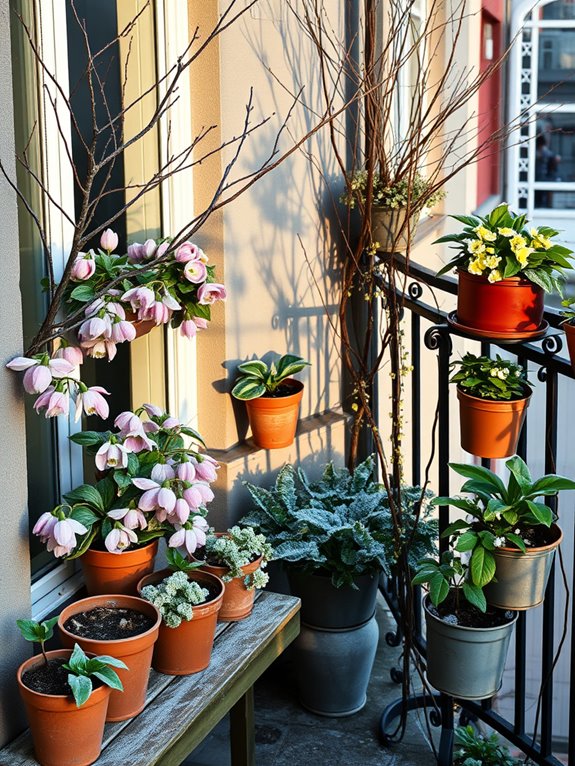
Transform your winter garden into a vibrant oasis with enchanting winter-flowering plants that defy the cold season’s stark palette. Hellebores, also known as Christmas roses, peek through frost-dusted soil with their nodding blooms in shades of white, pink, and deep purple, while clusters of fragrant winter honeysuckle climb garden structures, releasing their sweet perfume into the crisp air.
Delicate snowdrops create carpets of pure white beneath deciduous trees, complemented by the bold yellow blooms of winter jasmine cascading over walls and fences. The garden comes alive with witch hazel‘s spidery flowers in gold and copper tones, creating striking silhouettes against the winter sky.
Mahonia’s architectural leaves support sprays of yellow flowers, attracting rare winter pollinators, while cyclamen coum adds splashes of pink and magenta at ground level. Winter-flowering cherry trees provide height and drama, their pale pink blossoms appearing like delicate confetti against bare branches.
Essential Elements:
- Hellebores (Christmas roses)
- Winter honeysuckle
- Snowdrops
- Winter jasmine
- Witch hazel
- Mahonia
- Cyclamen coum
- Winter-flowering cherry
- Well-draining soil
- Protective mulch
- Windbreaks or sheltering structures
- Winter plant labels
- Gravel paths for winter access
Begin establishing your winter-flowering garden in early autumn to allow roots to develop before frost. Position taller specimens like witch hazel and winter-flowering cherry at the back of borders, creating sheltered microclimates for more delicate plants.
Group hellebores and cyclamen in drifts beneath deciduous trees, where they’ll receive winter sun once leaves fall. Install climbing supports for honeysuckle and jasmine near seating areas to maximize fragrance enjoyment.
For optimal success in any space, consider container gardening for smaller winter-flowering plants, enabling easy relocation to protected areas during severe weather. Balcony gardeners can focus on compact varieties like hellebores and cyclamen in frost-resistant pots, while using vertical space for climbing winter jasmine.
Ensure adequate drainage by elevating containers slightly off the ground, and cluster pots together to create mutual protection against harsh winds and temperature fluctuations.
Sculptural Elements and Garden Art
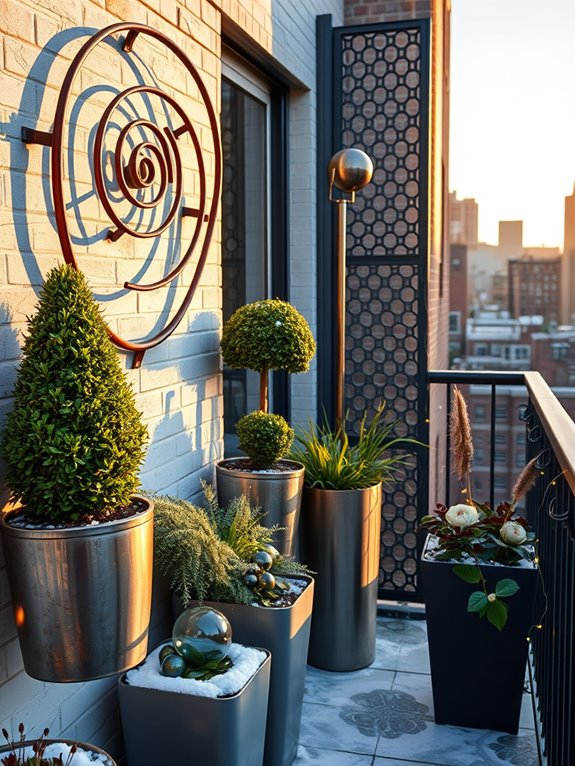
Winter gardens come alive with sculptural elements and garden art that transform bare spaces into enchanting outdoor galleries. Against the stark winter landscape, carefully placed sculptures, metalwork, and artistic features create dramatic silhouettes and focal points.
Bronze figures peek through frost-covered branches, while modern metal sculptures catch and reflect the low winter sunlight, casting ever-changing shadows across snow-dusted ground.
Glass orbs, weathered stone statuary, and architectural remnants add layers of visual interest when deciduous plants have shed their leaves. These artistic elements work in harmony with structural plants like boxwood spheres, spiral-pruned evergreens, and ornamental grasses that maintain their form through winter.
The combination creates a sophisticated outdoor space that remains visually compelling even on the coldest days.
Key Elements:
- Metal sculptures or architectural pieces
- Stone or concrete statuary
- Glass art elements (orbs, panels, or stakes)
- Mirror elements or reflective surfaces
- Structural evergreen plants
- Outdoor lighting fixtures
- Weather-resistant art pedestals
- Decorative obelisks or trellises
- Garden spheres or gazing balls
- Sculptural water features (if climate appropriate)
When implementing sculptural elements, begin by identifying key sight lines and focal points in your winter garden. Place larger pieces where they can be appreciated from indoor viewing areas, and arrange smaller elements to create visual pathways through the space.
Consider the scale of each piece in relation to its surroundings, ensuring proper proportions between art elements and plants. Install proper anchoring systems for stability during winter storms, and position lighting to highlight sculptural features during the shorter days.
Installation Tips:
Consider materials that weather gracefully in your climate, as some metals develop attractive patinas while others may require regular maintenance. Choose pieces that complement your home’s architectural style and integrate them with winter-interest plants.
For balcony gardens, focus on wall-mounted art pieces and smaller sculptures that can be secured safely. Select lightweight materials for upper-story installations, and ensure all pieces are properly anchored to withstand winter winds.
Container gardens can incorporate miniature sculpture collections or artistic stakes that add height and visual interest without overwhelming limited space.
Textured Foliage and Leaves
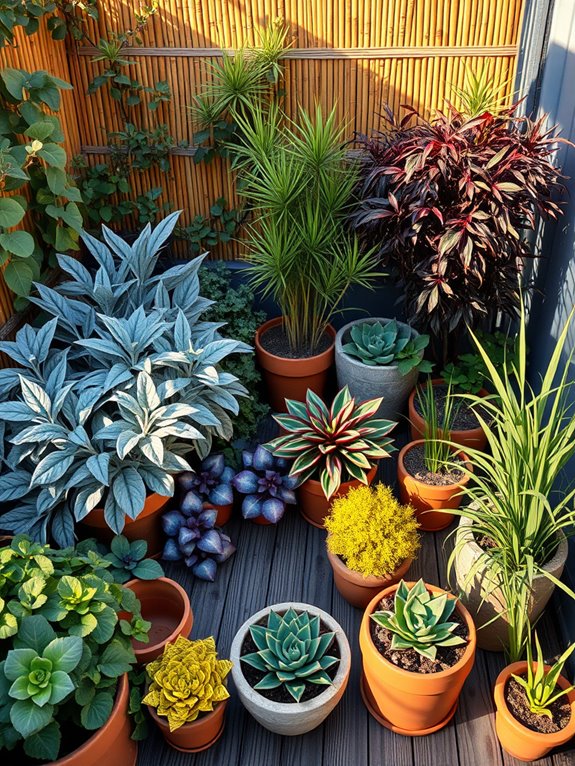
Even in winter’s monochrome palette, textured foliage creates a captivating visual symphony in the garden. Silver-frosted lamb’s ear cascades alongside the deep green, rippled leaves of bergenia, while the spiky silhouettes of ornamental grasses dance in the cold breeze. The varied surfaces – from glossy holly leaves to the matte finish of heuchera – catch light and shadow differently throughout the day, creating an ever-changing display that brings life to the winter landscape.
The layering of different leaf shapes and textures transforms an ordinary garden into an architectural masterpiece during the cold months. Broad-leafed fatsia japonica provides a bold backdrop for the delicate fronds of autumn ferns, while the peeling bark of paper birch trees adds vertical interest. The combination of smooth, rough, spiky, and fuzzy textures creates depth and interest even without flowering blooms.
Key Elements:
- Evergreen plants with contrasting leaf shapes
- Ornamental grasses
- Plants with interesting bark textures
- Multi-level planting areas
- Architectural plants with bold foliage
- Ground covers with varying textures
- Winter-hardy container plants
- Structural elements (trellises, obelisks)
- Natural stone or bark mulch
- Weather-resistant garden furniture
Start by establishing a framework of larger architectural plants as anchor points in your garden. Position these evergreen specimens at key viewing points, then work outward with medium-sized plants featuring different leaf textures.
Layer the ground plane with low-growing spreaders and mat-forming plants, ensuring each layer contains contrasting textures that complement rather than compete with each other.
Consider the viewing angles and sight lines when positioning plants, particularly from indoor spaces where you’ll spend more time during winter. Group plants with similar water and soil requirements together, and use mulch to protect root systems and add another layer of textural interest.
Maintain clean edges and defined spaces to highlight the textural contrasts and prevent the garden from appearing chaotic.
For smaller spaces or balconies, focus on container groupings with varied heights and textures. Use vertical gardening techniques with wall-mounted planters or tiered stands to maximize space.
Choose compact varieties of architectural plants and consider using artificial lighting to highlight textural elements during the shorter winter days. Remember that textures appear more pronounced when viewed up close, so don’t overcrowd your space – allow each plant enough room to display its unique characteristics.
Strategic Lighting for Dark Days
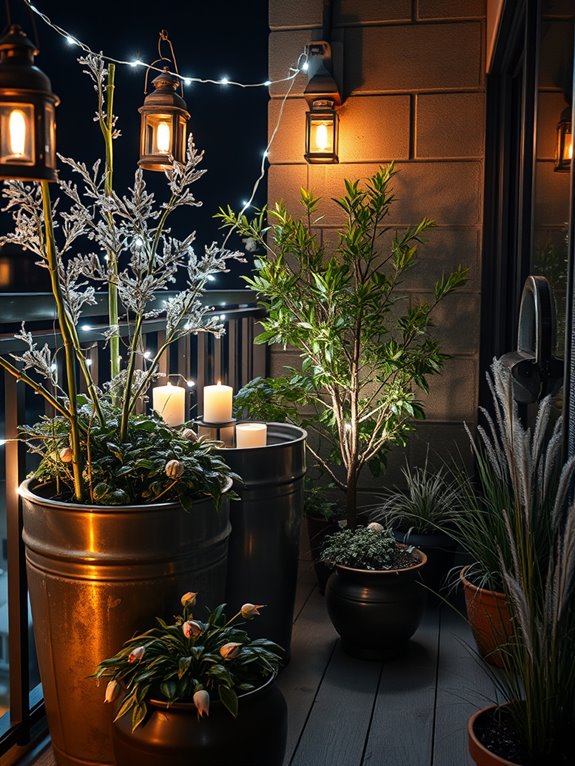
Strategic lighting transforms winter gardens from dark, dormant spaces into enchanting nighttime wonderlands. Soft uplighting casts dramatic shadows of bare branch structures against walls, while carefully positioned spotlights illuminate evergreen shapes and architectural plants like dogwoods and ornamental grasses.
The interplay of light and shadow creates depth, making the garden appear larger and more mysterious during the shortened daylight hours.
Path lighting weaves through the landscape like a string of pearls, guiding visitors through the space while highlighting interesting ground textures and winter-blooming plants like hellebores and witch hazel. Solar-powered stake lights intermingle with frost-resistant LED strips to outline garden beds and water features, creating a magical atmosphere that can be enjoyed from indoor viewing areas during the coldest months.
Key Elements:
- LED garden spotlights
- Solar-powered path lights
- Motion-sensor security lights
- Weatherproof extension cords
- Timer systems
- Uplighting fixtures
- Decorative string lights
- Light-reflecting ornaments
- White or light-colored hardscaping
- Reflective water features
Position lighting fixtures strategically to avoid harsh glare and create layers of illumination. Start with essential path lighting for safety, then add uplighting at the base of specimen plants or architectural features.
Install timer systems to automate operation during peak viewing hours and consider incorporating motion sensors for security areas. Ensure all electrical components are properly rated for outdoor use and protected from moisture.
Weather-resistant fixtures should be anchored securely and positioned to prevent water accumulation. Regular maintenance includes cleaning light covers, checking electrical connections, and adjusting angles as plants grow.
For maximum impact, combine different lighting types and angles to create depth and interest throughout the space.
For smaller spaces like balconies, focus on versatile lighting options such as battery-operated LED candles, string lights, and portable spotlights that can be easily repositioned.
Consider using reflective surfaces like mirrors or metallic planters to amplify light effects, and choose light fixtures that can be mounted on walls or railings to conserve floor space. In areas with strict electrical codes, solar-powered options provide flexibility without requiring permanent installation.
Winter Container Displays
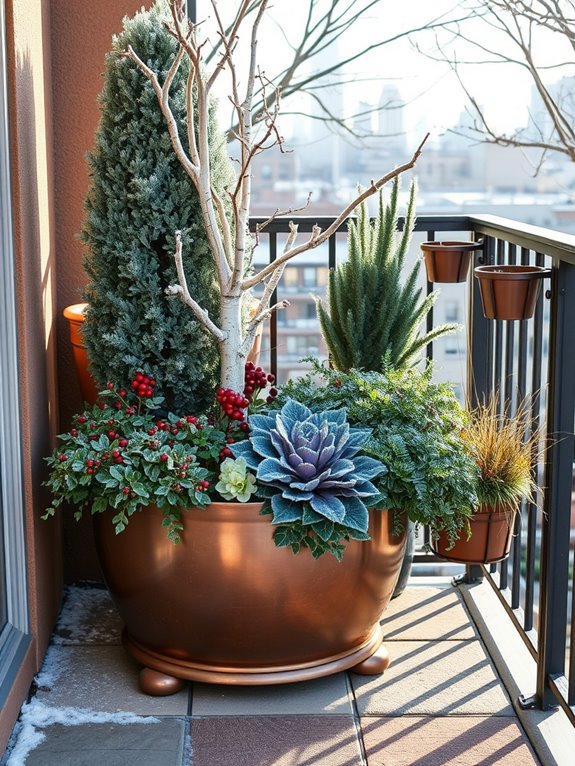
Winter Container Displays transform barren outdoor spaces into enchanting seasonal vignettes that sparkle with life even in the coldest months. Frost-kissed evergreens like dwarf spruce and boxwood create a strong foundation, while bright red winterberries and white-stemmed birch branches add striking vertical elements.
Copper or zinc containers filled with cascading ivy and topped with a layer of pristine snow create an elegant tableau that catches the low winter light and casts beautiful shadows across patios and entranceways. Clusters of containers in varying heights showcase layers of winter interest, from structural plants to decorative elements.
Hardy cyclamen and hellebores provide unexpected blooms, while silvery artemisia and dusty miller add frosty touches that complement winter’s palette. Ornamental cabbage and kale introduce bold textures and purple-tinged leaves that deepen in color as temperatures drop, creating a dynamic display that evolves throughout the season.
Key Elements:
- Frost-resistant containers (metal, stone, or thick plastic)
- Evergreen foundation plants
- Winter-blooming flowers
- Decorative branches and berries
- Trailing plants
- Cold-hardy ornamental grasses
- Weather-resistant decorative elements
- Quality potting soil with good drainage
- Protective mulch layer
Position containers where they’ll receive maximum visibility from both indoor and outdoor vantage points, grouping them in odd numbers for visual impact. Ensure proper drainage by elevating containers slightly off the ground using pot feet or blocks, and incorporate a layer of gravel at the bottom of each pot.
When planting, leave adequate space between specimens to allow for proper air circulation, which helps prevent frost damage and disease. The key to successful winter containers lies in proper preparation and protection. Use high-quality potting mix specifically formulated for winter conditions, and water thoroughly before the ground freezes.
Apply a thick layer of mulch to insulate roots and maintain consistent soil temperature. Consider incorporating outdoor lighting to highlight your display during the short winter days. For different-sized spaces, scale your display accordingly.
Balconies can accommodate slim containers mounted on railings or wall-mounted planters to maximize floor space. Larger areas benefit from groupings of containers in varying sizes, creating depth and interest. Consider wind exposure when selecting plants and securing containers, particularly for elevated locations.
Incorporate winter-proof decorative elements like glass baubles or LED lights that can withstand harsh weather conditions while adding sparkle to your winter garden display.
Native Plants for Winter Wildlife
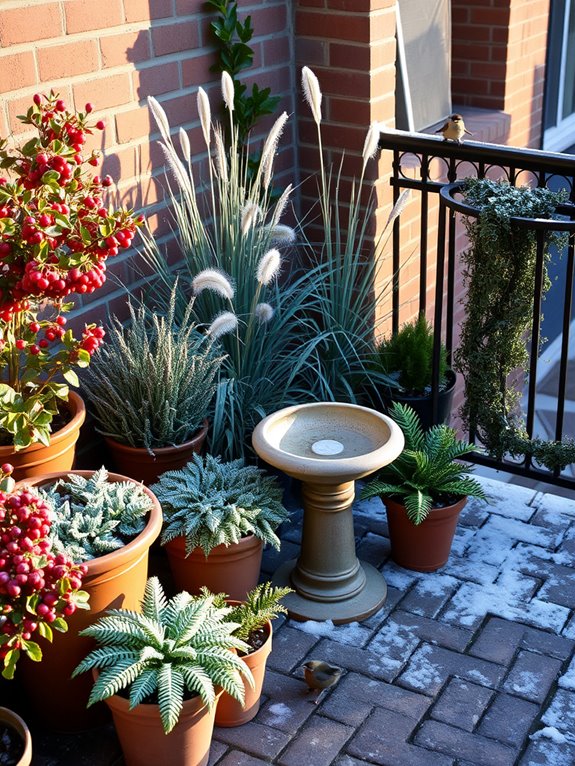
A winter wildlife garden transforms the cold season into a sanctuary of life and movement. Evergreen native shrubs like American Holly and Eastern Red Cedar create a robust backdrop while providing essential shelter and food for local birds.
Berry-laden branches of Winterberry and native Virginia Rose add splashes of vibrant red against the frost, their fruits attracting cardinals and chickadees that bring animation to the winter landscape.
Ornamental native grasses like Little Bluestem and Switch Grass stand tall through snow and ice, their seed heads offering vital sustenance to finches and sparrows. The dried flower heads of Purple Coneflower and Black-Eyed Susan remain upright through winter, creating natural bird feeders while adding architectural interest to the garden.
Dense thickets of native evergreen ferns nestle beneath, providing ground-level shelter for smaller wildlife.
Key Elements:
- Native evergreen shrubs
- Berry-producing plants
- Ornamental grasses
- Standing perennials with seed heads
- Ground cover plants
- Bird bath or water feature
- Brush piles
- Natural stone elements
- Native ground ferns
- Fallen log features
Implementation begins with establishing the foundational evergreen shrubs as windbreaks and shelter zones, positioning them along the garden’s perimeter.
Layer berry-producing shrubs in groups of three or five, creating feeding zones that offer protection from predators.
Install water features with heating elements to provide reliable drinking sources throughout winter, placing them near protective cover but away from predator hiding spots.
Maintain seed-bearing perennials by leaving them standing through winter, cutting them back only in early spring.
Extra Tips: When designing a winter wildlife garden, consider vertical space by including climbing native vines on walls or trellises, which works especially well for small spaces and balconies.
Container groupings can create microhabitats even in limited areas, while window boxes can support native winter-interest plants and provide food sources for birds.
In urban settings, focus on native plants that attract specific local wildlife species, and always include multiple levels of shelter and food sources, even in compact spaces.
